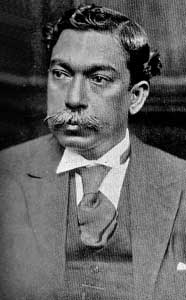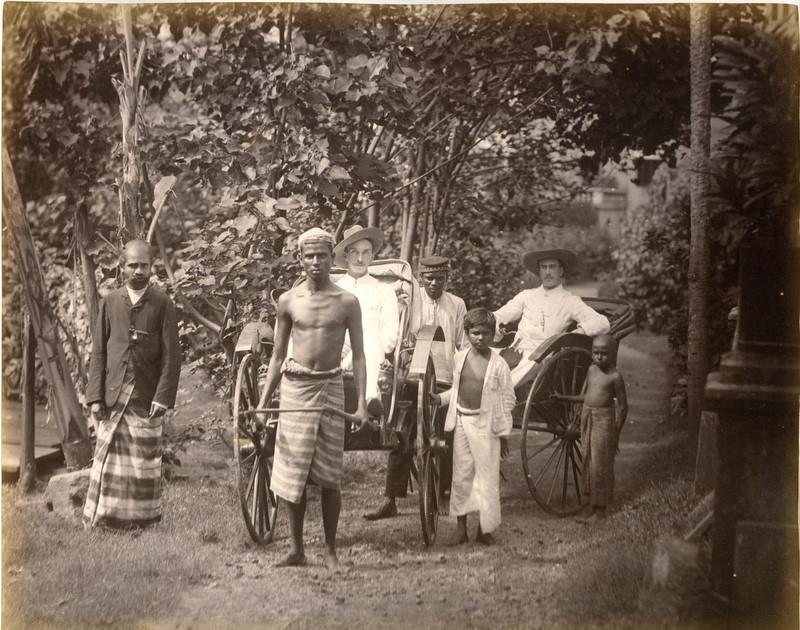Sunday Times 2
Judgment that triggered Martial Law riots in 1915 Ceylon
Martial Law was declared in 1915 in Ceylon by Sir Robert Chalmers the then Governor. The British Government Agent of Kandy was directly responsible for the riots.
The rioting was in consequence of the denial by the GA of the Central Province to the Buddhists of Gampola permission to conduct their

E.W. Perera
procession as of old from their temple, with music rights, through Ambegamuwa Street, to a part of the Mahaweli Ganga. An application was made to the GA by the Trustee/Nilame of the Devale, on August 27, 1912. But the British GA refused to grant his permission, on the ground that the Hambaya Mohameddans (not the Ceylon Moors), who had recently built a mosque in Ambegamuwa Street, objected to the Buddhist procession passing their mosque, with music. The Trustee of the Devale let the preparations for the procession temporarily slide, and instituted an Action in the District Court of Kandy in September 1913, complaining that the GA wrongfully and in breach of the Kandyan Convention (signed in 1815 by the British Government and the Kandyan Chieftains), refused the plaintiff permission to conduct the procession through that portion of the Ambegamuwa Street, within one hundred yards of the Hambaya Mohameddans’ mosque, with the accompaniment of music, as was done for hundreds of years.
With the coming of British Rule, a disturbing element crept in. The Coastal Moors from South India/ identified as the Hambaya Mohameddans (some of the most fanatical and intolerant among the Muslims of India) came to Ceylon in large numbers for purposes of trade, and were allowed to establish themselves in various towns. The Ceylon Muslims somewhat looked down upon these Coastal Moors. They, therefore, erected their own mosques for their worship. They then insisted on the stoppage of all music whenever a procession passed one of their mosques. This was a preposterous and unprecedented demand, which the British GA gladly gave into, in a predominantly Buddhist country of nearly 82% Buddhists, and not even half per cent Coastal Moors! Processions like peraheras play an important part in the religious and national life of the people. The stoppage of this particular procession was bound to lead to trouble. It was the obtuse intransigence of the Coastal Moors (the Hambayas) that was the direct cause of the Riots of 1915. The GA and the British authorities foolishly and short- sightedly backed the demands of the Coastal Moors. In any event, the British adopted the policy of Divide and Rule in all the countries they colonised.

Colonial life in Ceylon: Pic courtesy Srilankaequity.com
In this instance it boomeranged on the British.
For the “Diyakapana” ceremony, the procession from time immemorial had gone from the Devale along Ambegamuwa Street to Porutota, to the Mahaweli Ganga, with the accompaniment of music. It had to pass some Christian churches, Hindu temples and even some mosques of the Ceylon Moors. No one objected to this perahera with music, passing these places of worship. These Coastal Moors threatened to riot if the perahera passed with music, within 100 yards of their mosque.
On the refusal of the British GA to grant him a licence, Basnayake Nilame Tikiri Banda Elikewela on September 30, 1913, filed action against the British Attorney General of Ceylon. The plaint was settled by the well-known Kandy lawyer C.A. La Brooy. To this plaint, the AG filed answer through F.C. Liefching, settled by Sir Thomas Garvin – Solicitor General. Sir Thomas was later elevated as a Judge of the Supreme Court of Ceylon. He was assisted by Crown Counsel V.M. Fernando (later Justice Fernando).
The trial in the District Court of Kandy came up before a Christian judge, Sir Paul E. Peiris (D. Litt/Cantab), Barrister and of the Ceylon Civil Service. He was one of the cleverest judges of his day surpassing the intellect of many a British judge. The Judgment of the District Judge, Sir Paul, permitting the perahera to pass along the streets accompanied by music, was delivered in June 1914. He found that instead of binding the Hambaya Mohammedens of the mosque to keep the peace, the British GA directed the Police to plant pipes 50 yards away from each side of the mosque, and to inform the Buddhists that they should not sound their music while going over these 100 yards. Incidentally, Sir Paul’s daughter Miriam de Saram was a great meditator, though a practising Christian. Two of her sons Rohan and Druvi, are world famous musicians, the former a cellist and the latter a pianist.
At the Trial before Sir Paul, Sir Stewart Schneider with C.A. La Brooy, E.W. Perera, Charles Batuwantudawe and D.R. Wijewardene (owner of Lake House) appeared for the plaintiff. After the DJ Sir Paul gave judgment in favour of the Plaintiff, Basnayake Nilame, the British authorities promptly appealed against this judgment.
We can see to what extent they would go to appease those whom they are sponsoring. The present generation of British rulers is no better. The leopard can never change its spots. The appeal came up before Justice W.S. Shaw and Sir Thomas E. de Sampayo KC, and was argued from January 18 to 21, 1915. Sir Anton Bertram KC Attorney General, with James Van Langenburg KC Solicitor General, and V.M. Fernando Crown Counsel appeared for the Govt. B.W. Bawa KC with E.W. Perera and D.R. Wijewardene of Lake House fame appeared for Plaintiff-Respondent Elikawela. This was during World War I (1914 to 1918).
In 1915, the riots between the Sinhalese and the Coastal Moors broke out, and spread to Kandy and other neighbouring areas. The British panicked. They thought that this was to oust them from Ceylon. Governor Sir Robert Chalmers was determined to quell the riots by foul means or fair. He declared Martial Law, with orders to shoot the Sinhalese at sight. Before his arrival in Ceylon he was the financial genius of the British Treasury. He prepared the famous budget of Prime Minister Lloyd George in 1909. As a reward for his services he was sent to Ceylon as Governor. He was no administrator. He lived in an ivory tower in Queen’s House, Colombo, and Queen’s Cottage in Nuwara Eliya. He was a Pali scholar. Chalmers Granaries in Pettah was named after him. Now it houses the SL Customs.
Herbert Dowbeggin the IGP enlisted the British planters to quell the riots in the Central Province. Several Kandyan Chieftains were killed. Edward Henry Pedris (the son of William Pedris) was court martialled and shot dead in a gruesome manner by the British. It is reported that Edward Pedris’ father was prepared to give his son’s weight in gold to the British to save his life. Issipathanaramaya in Greenland Road was built by Edward’s father in his memory.
The great patriot Lawyer E.W. Perera braved the submarine-infested seas and sailed to England to make known the situation in Ceylon to the British authorities in London. It is said that this trip was financed by another patriot, Barrister F.R. Senanayake (brother of D.S. Senanayake). E.W. Perera whilst in England made a nuisance of himself to the Secretary of State for the Colonies, by persistently getting some Irish Members of Parliament to put awkward questions about the atrocities taking place in Ceylon by the British, in the suppression of the riots. The Secretary of State called upon Governor Chalmers for a report. It is said that E.W. Perera risked his life by smuggling a “Shoot at Sight” Order of the Governor, stitched into his shoe, when he set sail. Had it been detected in Ceylon, he would have surely been shot. Such were the dirty tactics of the British.
The whole country was inflamed by the atrocities committed by the Governor, the IGP and the Commander of the Army. Several leaders such as D.S. Senanayake, F.R. Senanayake, Charles Batuwanthudawe, the Hewavitharanes, Proctor A.A. Wickremasinghe of Kegalle were incarcerated and were to be shot. They committed no crime but agitated against the British as members of the Temperance Movement. One man who was perfectly unafraid was Proctor Wickremasinghe (father of Lawyer Winston and father-in-law of General Wijekoon) who boiled with indignation when he learnt of the wanton shooting of the poor villagers. When once roused by any injustice, nothing could stop him.
After E.W. Perera’s representations in England, and after being released from jail, DS, FR and Wickremasinghe were elected to a committee to collect necessary material, and a Memorial was sent to Bonar Law, the Secretary of State for the Colonies. Many commissions were appointed. The British here knew that the Ceylonese were going hell for leather for Independence, if nothing was done to redress the grievances of the Sinhalese.
Tamil Leaders headed by Sir Ponnambalam Ramanathan KC, and Sinhalese Leaders spoke in one voice. Governor Sir Robert Chalmers was recalled, and Sir John Anderson was sent to replace him. Though it appeared that Chalmers made an ignominious exit he was later made Lord Chalmers. This was no punishment for atrocities committed, but a reward for maintaining their policy of Divide and Rule.
To restore order, Governor Anderson gave peremptory orders that the perahera was not to be interfered with. The Coastal Moors climbed down and cooled their fanaticism. In 1917, Sir John Anderson himself attended the perahera as did the Sinhalese Kings of old, and the perehera marched thereafter along Ambegamuwa Street in all its splendour and glory, with the accompaniment of music.

